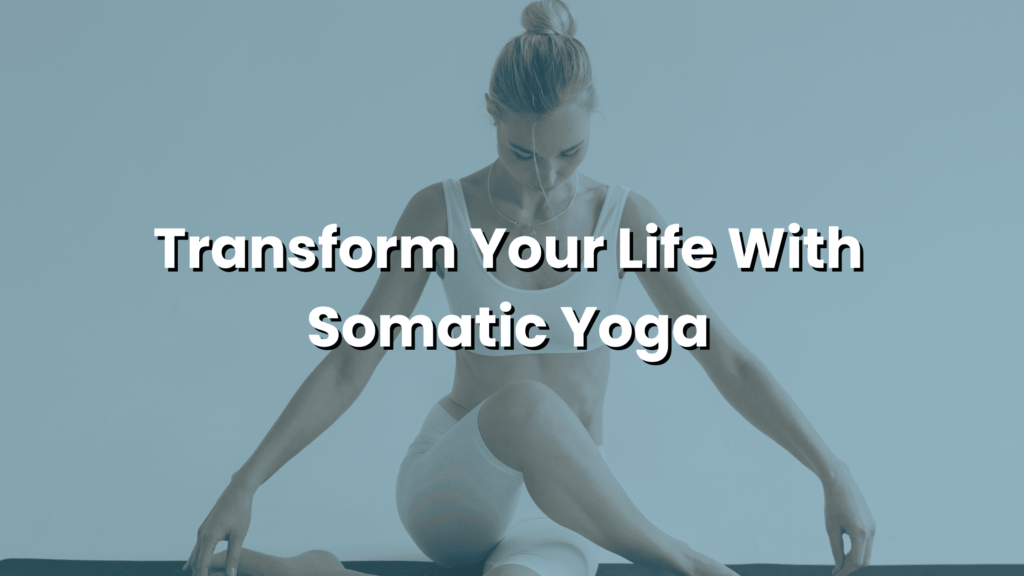In this blog we will know the power of Somatic Yoga with our comprehensive guide. Explore how Somatic Yoga can enhance your life and well-being. Learn more about Somatic Yoga techniques and its benefits today!
Imagine a practice that not only strengthens your body but also heals it from within, a practice that calms your mind while enhancing your mental clarity. Somatic yoga offers this and more, providing a holistic approach to well-being that empowers you to take control of your physical and emotional health. By focusing on the mind-body connection, somatic yoga allows you to release deep-seated tension, improve your posture, and cultivate a profound sense of inner peace. Whether you’re dealing with chronic pain, stress, or simply looking to enhance your overall quality of life, somatic yoga has the power to transform your life in ways you never thought possible.
Table of Contents
What is Somatic Yoga?
Definition and Key Principles of Somatic Yoga: Somatic yoga is a therapeutic practice that integrates mindful movement, breathwork, and meditation to enhance body awareness and release chronic tension. Rooted in the principles of somatics, which emphasize the internal experience of the body, somatic yoga encourages practitioners to focus on the sensations and movements from within, promoting a deeper connection between the mind and body.
Key principles include:
- Mindful Awareness: Cultivating a heightened awareness of bodily sensations and movements.
- Slow and Intentional Movement: Performing movements slowly and deliberately to facilitate greater control and awareness.
- Breath Integration: Using breath to enhance relaxation and movement.
- Non-judgmental Exploration: Encouraging a curious and compassionate attitude towards one’s body and its limitations.
Attention! Mayaro Virus: Are You at Risk?
Differences between Somatic Yoga and Traditional Yoga Practices

While traditional yoga practices often emphasize achieving specific postures and physical fitness, somatic yoga focuses more on the internal experience of the body. Key differences include:
- Focus on Sensation vs. Posture: Traditional yoga often emphasizes the external form of postures, whereas somatic yoga prioritizes the internal sensation and movement.
- Movement Pace: Somatic yoga typically involves slower, more deliberate movements compared to the sometimes dynamic flow of traditional yoga.
- Therapeutic Approach: Somatic yoga is more explicitly therapeutic, often used to address specific physical or emotional issues, whereas traditional yoga can be more generalized in its approach to health and fitness.
- Individual Experience: Somatic yoga emphasizes personal exploration and the subjective experience of the practitioner, rather than adherence to a prescribed sequence of poses.
Benefits of Somatic Yoga

Physical Benefits
Improved Flexibility and Mobility
- Somatic yoga promotes gentle stretching and mindful movement, which can help increase flexibility and improve overall mobility.
- By focusing on the internal experience of movement, practitioners can safely and effectively enhance their range of motion.
Relief from Chronic Pain and Tension
- Many people suffer from chronic pain due to muscle tension and stress. Somatic yoga helps release this tension through slow, intentional movements.
- Regular practice can alleviate pain in areas such as the back, neck, and shoulders by promoting relaxation and muscle awareness.
Enhanced Muscle Awareness and Control:
- Somatic yoga teaches practitioners to become more attuned to their bodies, improving proprioception (the sense of body position and movement).
- This increased awareness helps individuals gain better control over their muscles, leading to improved posture and movement efficiency.
Mental and Emotional Benefits
Reduction in Stress and Anxiety:
- The mindfulness and breathwork components of somatic yoga are effective in reducing stress and anxiety.
- Practicing somatic yoga can activate the parasympathetic nervous system, promoting a state of calm and relaxation.
Improved Mental Clarity and Focus:
- By encouraging a mindful approach to movement, somatic yoga can help clear mental clutter and enhance focus.
- Regular practice can lead to better concentration and a more centered mind.
Enhanced Emotional Resilience and Well-being:
- Somatic yoga fosters a compassionate and non-judgmental attitude towards oneself, which can improve emotional resilience.
- The practice encourages emotional release and processing, leading to a greater sense of well-being.
Similar: Top 10 Relaxation Techniques for Teens: Find Your Calm!
Overall Wellness
Better Sleep Quality:
- The relaxation and stress-reduction techniques used in somatic yoga can improve sleep quality.
- By helping to release physical and mental tension, somatic yoga can make it easier to fall and stay asleep.
Boosted Energy Levels:
- Regular somatic yoga practice can increase energy levels by reducing stress and promoting relaxation.
- Improved muscle function and body awareness can lead to more efficient movement and less fatigue.
Enhanced Overall Quality of Life:
- The combined physical, mental, and emotional benefits of somatic yoga contribute to a higher overall quality of life.
- Practitioners often report feeling more balanced, grounded, and connected to their bodies, leading to greater satisfaction and well-being in daily life.
Have A Look At Why Try Naked Yoga? Embracing Body Positivity and Self-Acceptance!
Incorporating Somatic Yoga into Your Daily Routine
Tips for Beginners on Getting Started
Start Slow
- Begin with short, gentle sessions to allow your body to adapt to the new movements and sensations.
- Focus on understanding the principles of somatic yoga and how it differs from traditional yoga practices.
Listen to Your Body
- Look after your body that how it feels during and after each practice. Avoid pushing yourself too hard or causing discomfort.
- The goal is to move mindfully and with awareness, not to achieve a specific pose or level of flexibility.
Learn from a Qualified Instructor:
- Consider taking a few classes with a certified somatic yoga instructor to learn the basics and receive personalized guidance.
- Online classes and tutorials can also be a great resource if in-person instruction is not available.
Practice Mindfulness:
- Somatic yoga is as much about the mind as it is about the body. Incorporate mindfulness and deep breathing into your practice.
- Focus on the internal experience of movement and sensation, rather than external appearances or goals.
Suggested Daily Practices and Routines

Morning Routine:
- Start your day with a short somatic yoga session to awaken your body and mind.
- Incorporate gentle stretches and movements that target areas of tension, such as the neck, shoulders, and lower back.
Midday Break:
- Take a break from work or daily activities with a quick somatic yoga practice to refresh and re-energize.
- Focus on movements that counteract the effects of prolonged sitting, such as hip openers and spine stretches.
Download Your Weekly Meal Plan Template: Your Go To Meal Prep
Evening Routine:
- Wind down in the evening with a relaxing somatic yoga session to release the day’s tension and prepare for sleep.
- Incorporate calming movements and deep breathing exercises to promote relaxation and reduce stress.
Specific Practices:
- Body Scan: A mindful body scan can help you become more aware of tension and relaxation in different parts of your body. Start from your head and move down to your toes, paying attention to each area.
- Cat-Cow Stretch: This gentle spinal movement can help increase flexibility and reduce tension in the back. Move slowly and mindfully between arching and rounding your spine.
- Shoulder Rolls: Sit or stand comfortably and roll your shoulders forward and backward, paying attention to the release of tension in your upper body.
Creating a Habit:
- Set aside a specific time each day for your somatic yoga practice to make it a regular part of your routine.
- Start with few minutes a day and then increase the duration after you become more comfortable with the practice.
By incorporating these tips and routines, you can make somatic yoga a regular part of your daily life, reaping its many physical, mental, and emotional benefits.
Getting Started with Somatic Yoga
Resources for Beginners
Books:
- Somatics: Reawakening The Mind’s Control Of Movement, Flexibility, And Health by Thomas Hanna
- Move Without Pain by Martha Peterson
- The Body Keeps the Score: Brain, Mind, and Body in the Healing of Trauma by Bessel van der Kolk (although not solely about somatic yoga, it provides a deep understanding of the mind-body connection)
Websites:
- Somatic Yoga: Somatic Yoga
- Essential Somatics: Essential Somatics
- Somatic Movement Center: Somatic Movement Center
Online Classes:
- YouTube Channels:
- Online Platforms:
Recommended Poses and Sequences for Starting Out
Basic Somatic Yoga Poses:
Arch & Flatten:
- Lie on your back with your knees bent and feet flat on the floor.
- Gently arch your lower back, pressing your tailbone into the floor, and then flatten your back against the floor.
- Focus on the sensations in your lower back and pelvis.
Pelvic Tilts:
- Lie on your back with your knees bent and feet flat on the floor.
- Slowly tilt your pelvis forward and backward, feeling the movement in your lower back and hips.
Cat-Cow Stretch:
- Keep your hands and knees in a tabletop position.
- Inhale as you arch your back, lifting your head and tailbone towards the ceiling (Cow Pose).
- Exhale as you round your back, tucking your chin and tailbone under (Cat Pose).
- Move slowly and mindfully, paying attention to the sensations in your spine.
Shoulder Rolls:
- Sit or stand comfortably.
- Roll your shoulders forward in a circular motion, and then backward.
- Focus on releasing tension in your shoulders and upper back.
Head and Neck Release:
- Sit comfortably with your spine straight.
- Slowly tilt your head to one side, bringing your ear towards your shoulder.
- Hold for a few breaths, then switch sides.
- Focus on releasing tension in your neck and shoulders.
Beginner Sequences:
Morning Wake-Up Sequence:
- Start with a body scan, lying on your back and bringing awareness to each part of your body.
- Move into Arch & Flatten, followed by Pelvic Tilts.
- Transition to Cat-Cow Stretch, then move into a seated position for Shoulder Rolls.
- End with a few minutes of mindful breathing and setting an intention for your day.
Midday Refresh Sequence:
- Begin with a few minutes of mindful breathing, focusing on the breath’s rhythm.
- Move into Shoulder Rolls and Head and Neck Release.
- Transition to Cat-Cow Stretch, then into Pelvic Tilts.
- Finish with a seated meditation or a short body scan.
Evening Wind-Down Sequence:
- Start with a body scan, lying on your back and bringing awareness to each part of your body.
- Move into Arch & Flatten, followed by Pelvic Tilts.
- Transition to Cat-Cow Stretch, then move into a seated position for Shoulder Rolls.
- End with a few minutes of mindful breathing and setting an intention for your day.
Success Stories and Testimonials

Real-Life Examples of Transformation with Somatic Yoga
1. Jane’s Journey to Pain-Free Living: Jane, a 45-year-old mother of two, suffered from chronic lower back pain for over a decade. Traditional treatments and physical therapy offered temporary relief, but the pain always returned. After discovering somatic yoga, Jane began incorporating daily practices into her routine. Within three months, she noticed a significant reduction in pain and improved mobility. Jane says, “Somatic yoga has given me my life back. I can play with my kids without worrying about my back anymore.”
2. Michael’s Path to Stress Reduction: Michael, a 38-year-old software engineer, struggled with high stress and anxiety due to his demanding job. He found it difficult to relax, and his mental health began to suffer. A friend recommended somatic yoga, and Michael decided to give it a try. The mindful movements and focus on breathwork helped him release tension and calm his mind. Michael shares, “Somatic yoga has been a game-changer for me. I feel more centered and less anxious, even on the busiest days.”
3. Emma’s Enhanced Athletic Performance: Emma, a 28-year-old professional dancer, experienced frequent muscle stiffness and injuries. Seeking a way to improve her flexibility and prevent injuries, she turned to somatic yoga. The gentle, mindful movements helped her gain better body awareness and control. Emma reports, “Incorporating somatic yoga into my training routine has made a huge difference. My flexibility has improved, and I feel more in tune with my body. It’s been an essential part of my performance enhancement.”
4. David’s Recovery from Trauma: David, a 50-year-old veteran, struggled with PTSD and physical injuries from his time in the military. Traditional therapies were helpful but didn’t address the physical manifestations of his trauma. Through somatic yoga, David found a way to reconnect with his body and release stored tension. He explains, “Somatic yoga has been a crucial part of my healing process. It’s helped me find peace and regain control over my body and mind.”
5. Laura’s Weight Loss and Wellness Journey: Laura, a 35-year-old teacher, wanted to lose weight and improve her overall health. She found traditional exercise routines challenging and unsustainable. After starting somatic yoga, Laura discovered a form of exercise that was gentle yet effective. She combined it with mindful eating and saw remarkable results. Laura says, “Somatic yoga has helped me lose weight and feel better than ever. It’s not just about the physical changes but the mental clarity and sense of well-being I’ve gained.”
Recap
Somatic yoga is more than just a form of exercise; it’s a holistic approach to well-being that integrates mind, body, and spirit. By focusing on gentle, mindful movements and breathwork, somatic yoga offers profound physical, mental, and emotional benefits. Whether you’re looking to improve flexibility, relieve chronic pain, reduce stress, or enhance your overall quality of life, somatic yoga provides a transformative practice that can fit seamlessly into your daily routine.
With its accessible and inclusive nature, somatic yoga is suitable for individuals of all ages and fitness levels. As demonstrated by the real-life success stories, incorporating somatic yoga into your lifestyle can lead to remarkable improvements in health and wellness. Begin your journey today by exploring the resources available for beginners and gradually integrating somatic yoga into your daily practice. Transform your life with somatic yoga and experience the profound benefits it has to offer.








